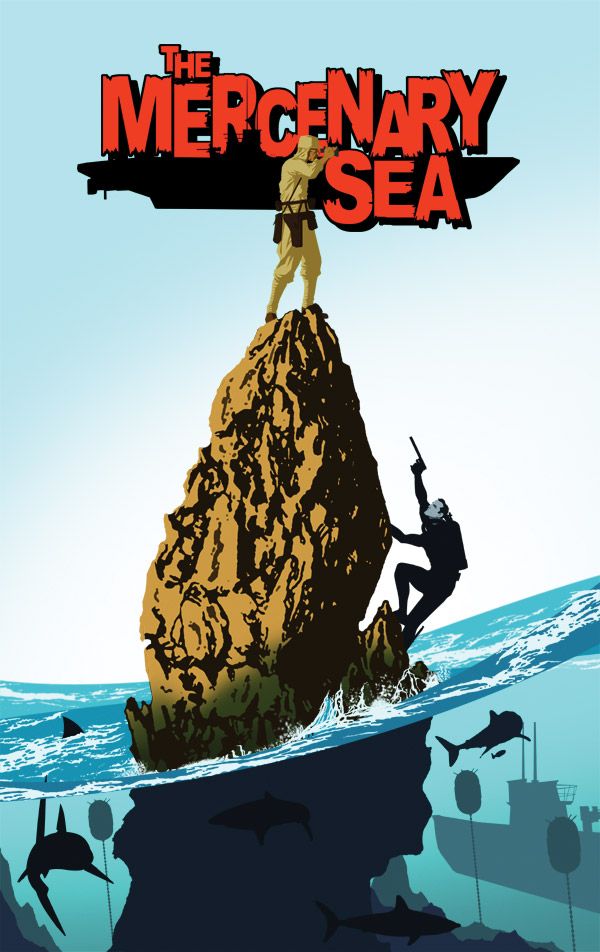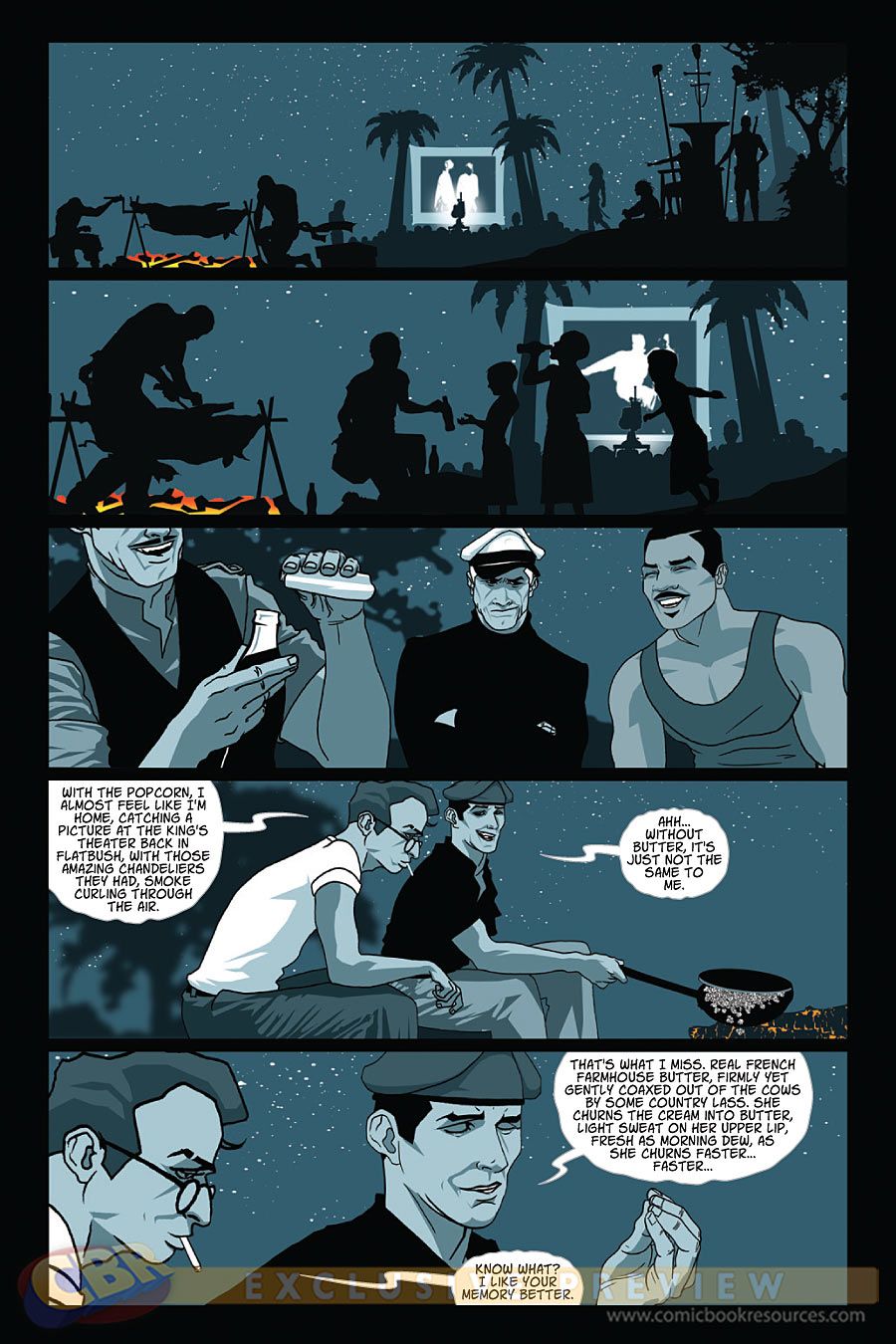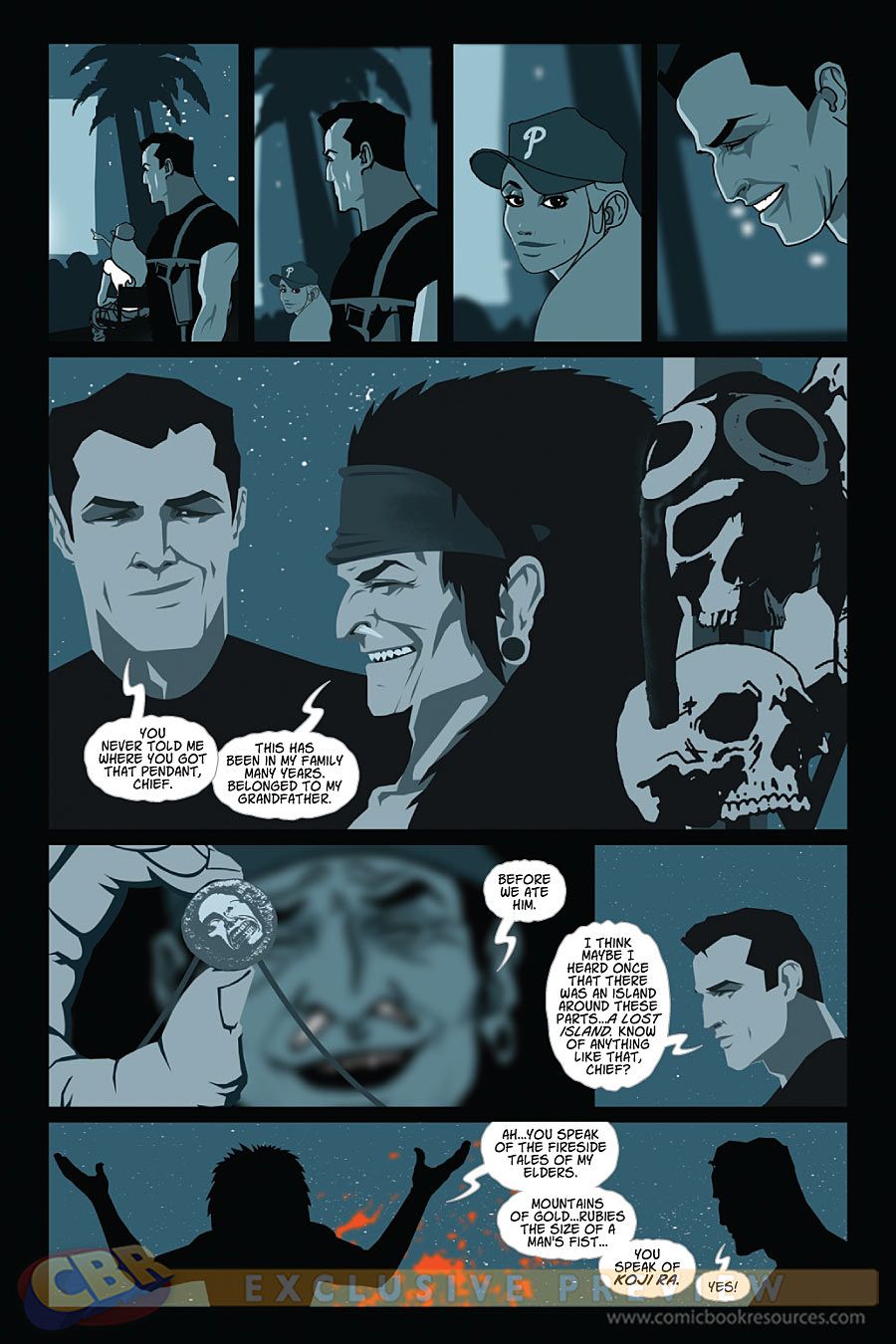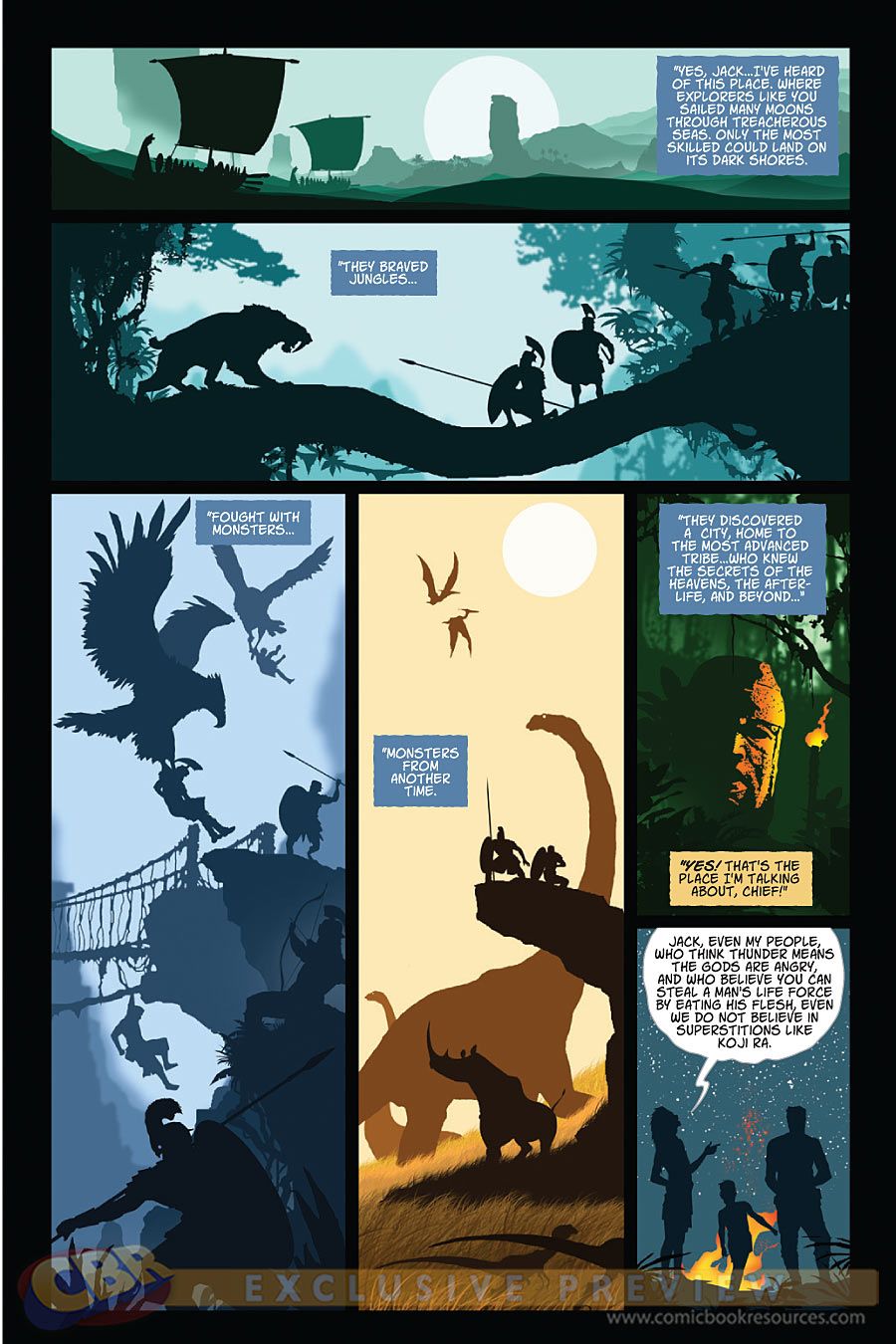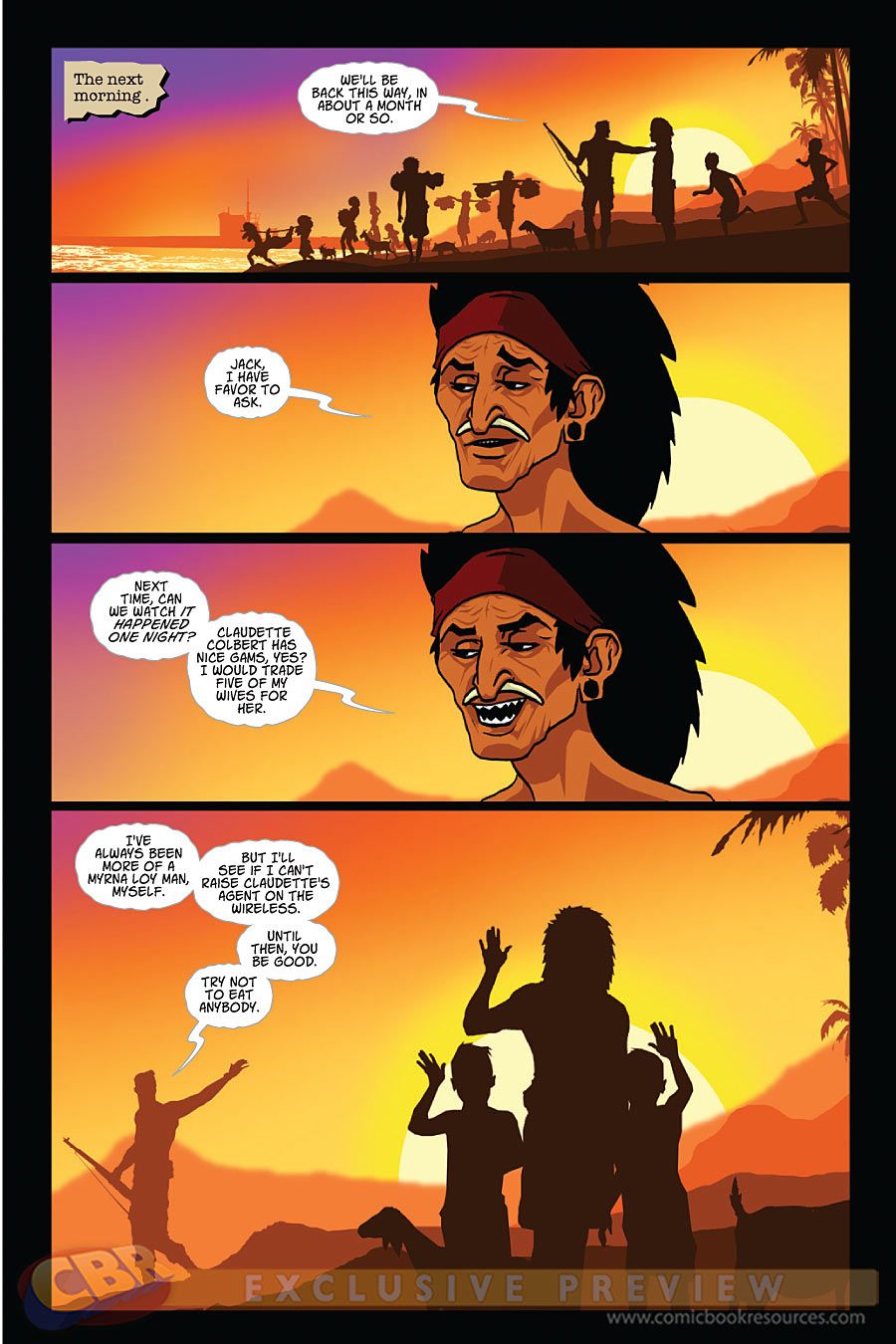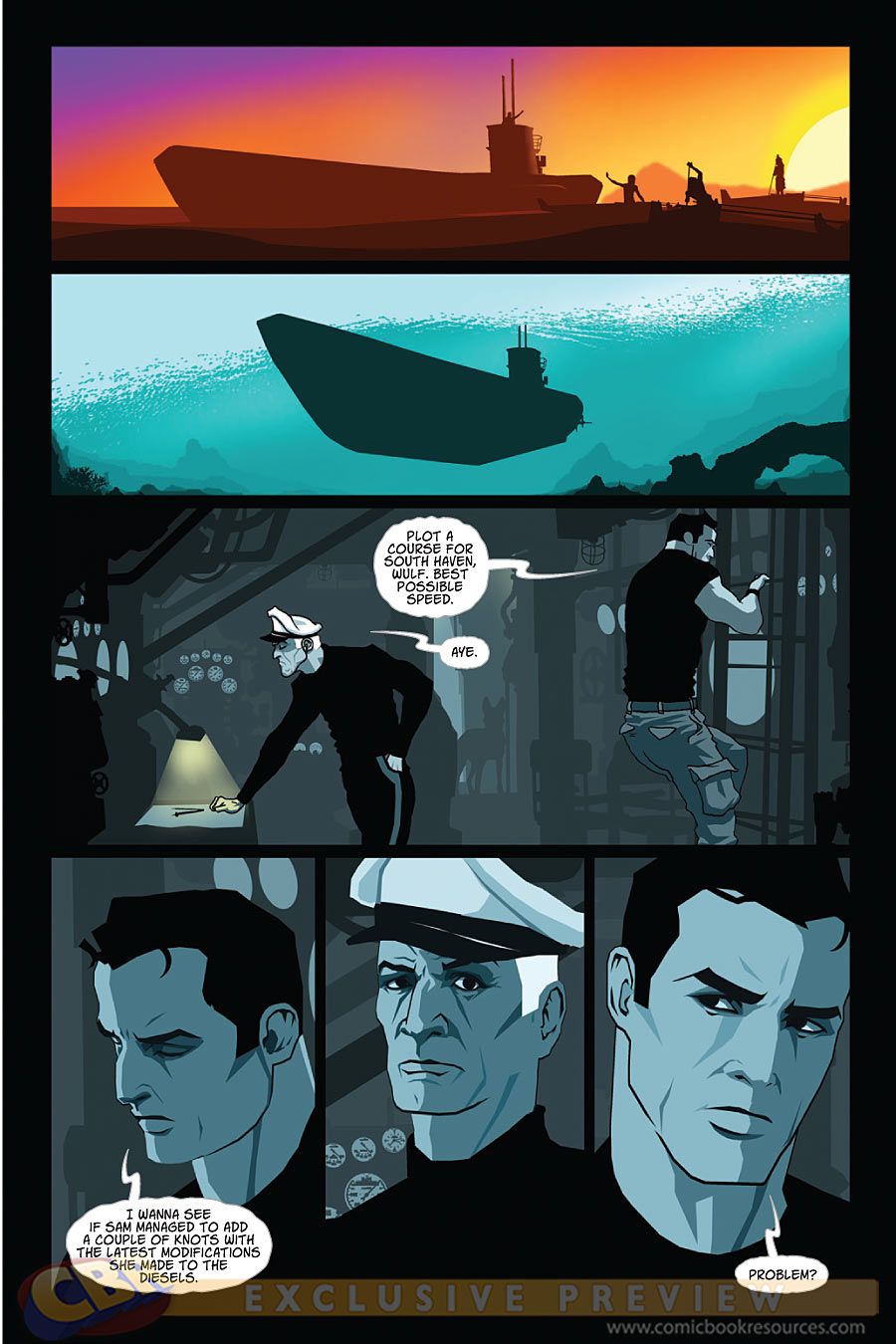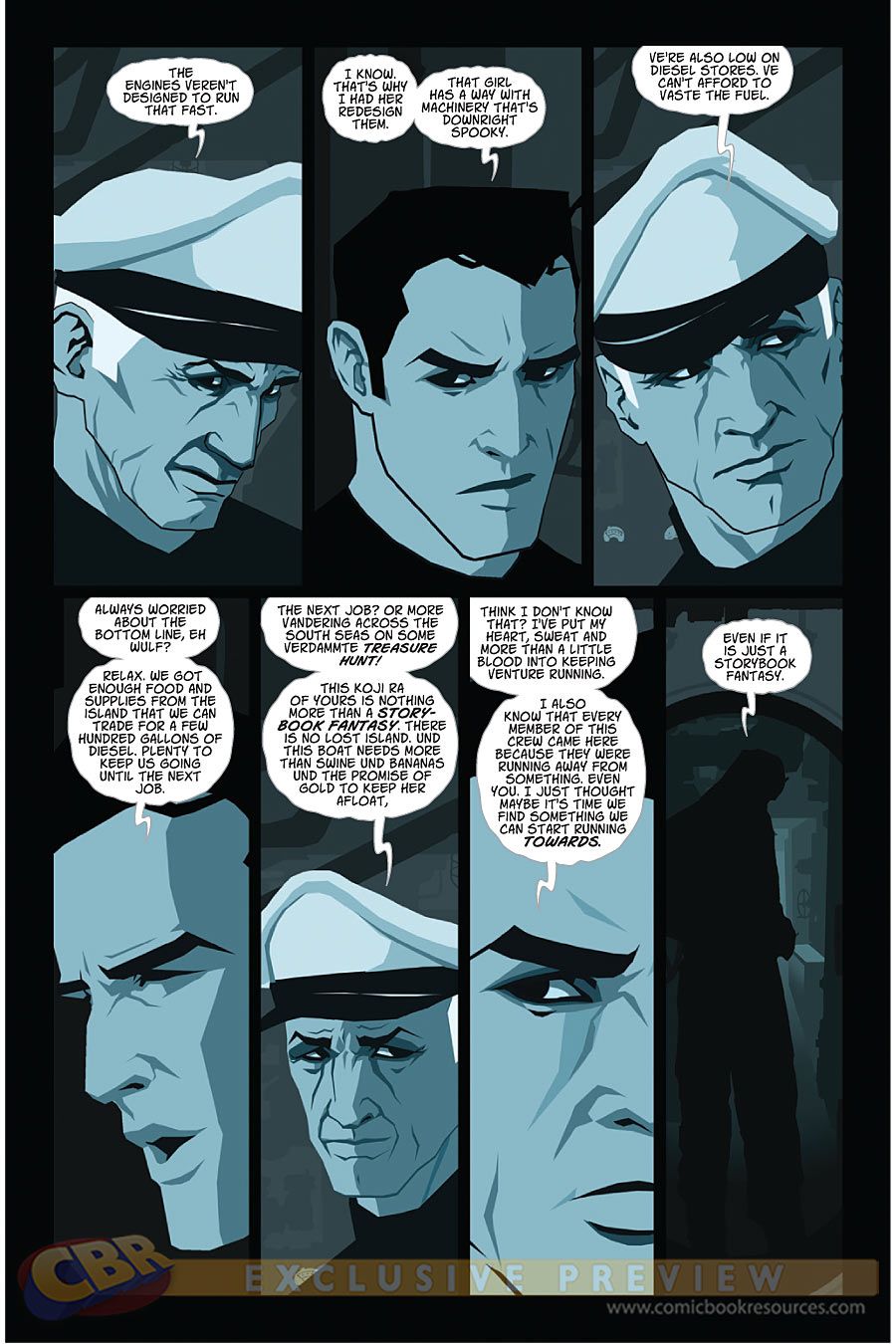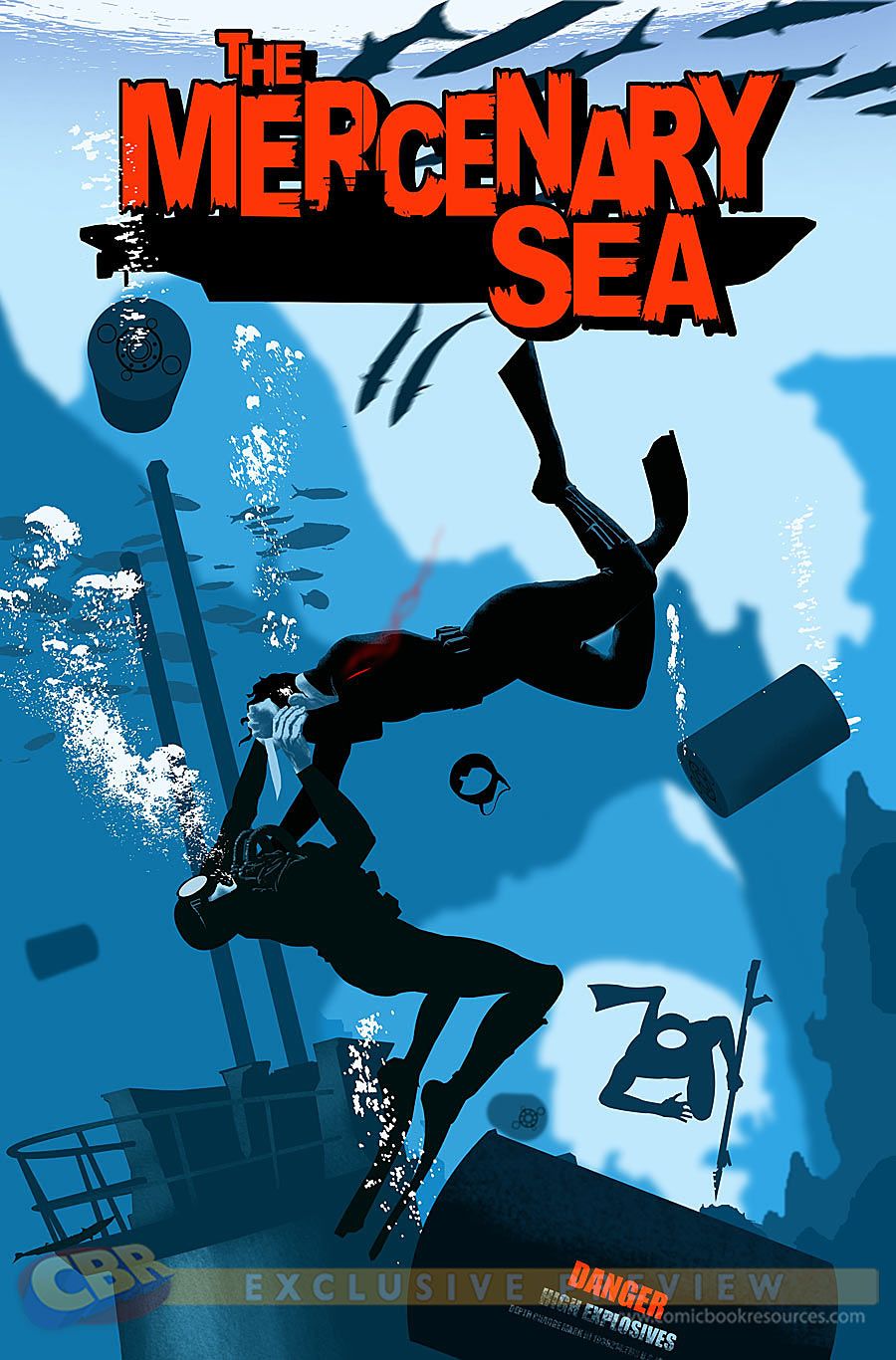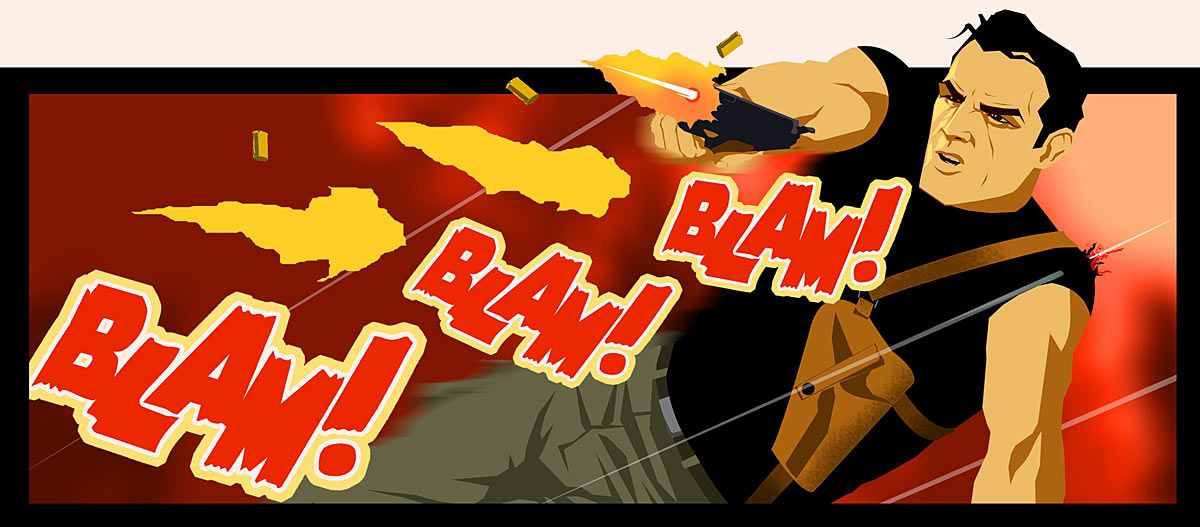Jack Harper is a man of action. An ex-bootlegger turned captain of The Venture, his life's pursuit is the thrill of adventure. After an ugly run-in with a mobster, Jack flees the States and finds himself in a submarine stolen from the Chinese Navy, pirating around the South Seas with his crew of salty ex-pats in tow. They've set their sights on treasure and are prepared to take down headhunters, pirates and anything else that stands in their way. Find out what it takes to stay afloat on "The Mercenary Sea."
Writer Kel Symons and artist Mathew Reynolds have parlayed their mutual love for classic adventure stories into a sharp, swanky comic coming February 12 from Image Comics. Symons and Reynolds spoke with CBR News about their complex hero, and how iconic leading men of the past from Indiana Jones to Han Solo have inspired their new ongoing series.
CBR News: Kel, how did you get into writing comics?
Kel Symons: Chance, really. Eric Stephenson, the publisher at Image, is a friend. I come from a background in development and writing for film and TV, and we were talking one day and he said I should come pitch them something some time. Only I didn't really have a huge experience with comics -- I mean, I read them."Batman" stands out as a favorite, mostly because I liked the gritty, noir-ish tone to the stories. But growing up, movies were what I loved most of all. So I feel like I missed out on that shared comics experience most industry professionals had in their teenage years. Though I think I've made some great strides in catching up.
Does your experience in film/television make comics writing an easier transition?
Symons: I don't know if it made it "easier" necessarily -- the learning curve was short. There might have been a couple kinks to work out in the transition, but I think writing is writing, for the most part -- formats might change a bit, but it's still about telling a good tale. I think Hollywood is starting to wake up to that, as I see more and more writers from comics transitioning to TV and movies.
The audience reading your stuff is different, though. For instance, when I write a film script, I know it's probably going to be read by dozens of people -- first by development executives, producers or agents. Then if fortune favors you, maybe by directors and craftsmen -- so it's this larger, more collaborative machine, I think.
But with a comic script, it's really just me and the artist, and maybe the letterer or colorist. But it's a smaller group -- there's an intimacy there, almost like it's a conversation you're having between friends. Maybe sometimes that makes my action description a little more colloquial, like I know I'm describing this thing -- this panel -- to just one person. And maybe after a while, you develop a shorthand. But honestly, I would say my writing in a script for a comic book is largely indistinguishable from a TV or film script I write.
Film is still in my DNA, though. I think even after a couple books under my belt, I still approach my comic scripts cinematically -- even to the point of using film terms when I write -- "wide aerial shot," "medium close up," "tight on," "two-shot," etc. So far none of the artists I'm working with have commented on that, so maybe that's how a lot of people in this business think. With Mathew, almost every touchstone we used as inspiration came from the movies and TV. We probably just grew up watching and loving the same things.
Kel Symons Professes "I Love Trouble"
How did you come to Image?
Symons: It was one of those stories where I basically had an "in" at the publisher. A rabbi in the business, Eric Stephenson.He kept after me to bring him material, and after I worked on "I Love Trouble" for Image, I started sending him new stuff.
Aside from the obvious -- that Image is consistently putting out great content -- the simple reality is that I don't really know anyone at any other comic publishers, so the easy answer to "How did I come to Image" might be: "by default." But seriously, what a great default setting, right?
How did you connect with your team for "The Mercenary Sea?"
Symons: I was scrolling through articles on the website io9 when I came across some of Mathew Reynolds' art that had all these monochromatic silhouettes of scenes involving Indiana Jones in new adventures -- like Indy going over the falls with a German patrol boat, or stalking through the jungles after some relic... even going up against a ninja. Really cool stuff. The art was both simple and complex at the same time, with a forced perspective giving it real depth, almost like two-dimensional action-packed dioramas.
I reached out to Mathew, who lives in Texas. Originally I just wanted to see if he'd give me hi res images -- thought I'd use them for wallpaper or screen savers on my computer or something. Anyway, we struck up an e-correspondence and started talking about favorite movies from the '40s, adventure books, etc.Next thing you know we're hatching an idea to do this series.
Our letterer, Patrick Brosseau, I worked with previously on my first comic for Image, "I Love Trouble." He's great, and as soon as I told him what we were working on, he told me he wanted to do the dialogue balloons in this European style.
We also worked with a freelance story editor on this one, Sebastian Girner, whom I heard about from another creator, James Asmus. He was a lot of help, not just in keeping the story and ensemble cast straight, but it turns out he also has a background in Asian studies and history, which really worked out given the setting was the South Seas during the Japanese invasion of China prior to WWII. I believe he also speaks German, which was helpful with some of Wulf's dialogue.
A lot of the inspirations you pulled from are cinematic -- classic hero stories. How do you keep that same level of adventure in your comic?
Symons: I don't know. I can only try and hope that I do. My inspirations for "The Mercenary Sea" are drawn from a lot of sources. The way I originally pitched it was like "Raiders of the Lost Arc" meets "Firefly". There's also some "Johnny Quest" in there, "King Kong," too. And Mathew and I always talked about doing this like a lost Howard Hawks film -- in the vein of "To Have and Have Not" or "Only Angels Have Wings"-- movies about honorable but desperate men, often in far off places, trying to carve out a living in one of the last frontiers. I knowMathew took some of his inspiration from the combat comics he grew up on, and Edgar Rice Burroughs.
But there's also this series of three books that I loved as a kid, "The Han Solo Adventures" written by Brian Daley, which take place before "Star Wars." Kind of like Han and Chewie, the early days. This was before there were thousands of spin-off stories set in the "Star Wars" universe -- so many I gave up decades ago trying to keep up with them. But back then; between "Star Wars" and "Empire" if you were still chasing the krayt dragon, so to speak, your only fix was these three Han Solo novels, the Marvel comics, and "Splinter of the Mind's Eye," which followed Luke and Leia.
But what can I say; I was always a bigger fan of Han than Luke. Isn't everyone? Jack Harper, our main character, is definitely cut from Han's mold.
Tell me more about Captain Jack Harper. What's he like?
Symons: He's a romantic, in love with the idea of adventure. He grew up reading tales of Edgar Rice Burroughs, and books like "Robinson Crusoe" and "Treasure Island." He names his submarine "The Venture" because that's the name of the freighter from "King Kong" -- his favorite movie. He's a bit of a dreamer, that guy who's always looking for the big score. Though I'd imagine if he ever got what he wanted, the payoff wouldn't satisfy him half as much as journey to get there.
Before we meet him, Jack was a smuggler and boat captain, running whiskey from Canada during Prohibition (not spices for Jabba -- see what I did there?) A rival of his, a Boston mobster, dimes Jack out to the feds, and Jack has to leave the States or face arrest and life in prison. He bums around the world for a few years until he's given a chance to captain an old German U-boat from the First World War in service of the Chinese Navy. They're under invasion by Japan, and completely out-classed at sea, relying on western mercenaries to help even the odds. Eventually that gig turns sour and he finds himself stealing the boat and freelancing on the South Seas.
What kind of a crew has he surrounded himself with?
Symons: A bunch of mutts, expats and fortune hunters like himself, mostly. They've all lost their way and wound up aboard the Venture with Jack by one route or another, coming together as a sort of extended family.
There's Wulf Renner, a grizzled German U-Boat captain still dealing with traumas from the war. The wily scrounger and cook, Jarreau, a former French Legionnaire. "Smokestack" Jackson, a heavyweight fighter from Chicago who refused to throw a fight and was framed for murder. The mild and unassuming Toby, whose last employer was Murder Incorporated. "Doc," a British Army surgeon who lost his license after operating on a patient while drunk. Samantha, daughter of a moonshiner Jack used to work with, who's now in prison, but taught Sam everything he knew about souping up engines. Kevin, the taciturn South Seas islander (whose real name no one can pronounce), and 17-year-old Do, a Chinese machinist's mate. Oh, and Friday, their dog.
What are they after?
Symons: Mostly they're just trying to scrape by, earning enough money running cargo here and there to keep afloat. Trading with a variety of island natives, giving one tribe Cokes and a chance to see a movie, in exchange for various foodstuffs, etc., which they can trade for diesel. But as I said, Jack's something of a dreamer -- chasing after rumors, stories and legends of an island out of time, "Koji Ra," home to all sorts of strange beasts, a lost civilization, and fabled mountains of gold and gems. Sort of Shangri La meets Skull Island. It's his idea of that last, big score I mentioned.
The artwork is so stylized -- was this the look you imagined for the story as you were writing it?
Symons: Well, I certainly knew what I'd be getting from Mathew, having seen his other work, so it was pretty much as I imagined it. There was a moment there we were flirting with the idea of doing the story in black and white only, like a lost classic by Howard Hawks or something. But I think making it full color was definitely the way to go.
What do you think makes a really great adventure story?
Symons: That's a tough one. I don't know that there are any set criteria, or boxes you can check off, like -- rough and tumble hero? Check. Damsel in distress? Check. Evil villain? Check.
You just hope that what you're writing is entertaining. I mean, that's what good storytelling is all about.
Mathew -- what was coming together with Kel like for you?
Mathew Reynolds: I had done some "Indiana Jones" pieces. They are very much inspired by the work of Fredric Remington and Charles Russell, not style-wise but content-wise. I love to tell a story with one piece, like those two painters used to. I knew I was bored with "pin-up" style work and I was getting bored with traditional line work. I wanted to achieve a sense of environment and mood. That gradient look in the "Jones" work allowed me to do that. Allowed me to achieve depth in a way that was very interesting to me -- something that looked more like a miniature model or diorama.

Symons and I realized real quick that we had a mutual love for old school adventure stories. He was generous enough to ask me what I'd like to do. We started talking about "King Kong," "The Dirty Dozen," "The Magnificent Seven," "Mysterious Island," "Journey to the Center of the Earth" -- fun stuff like that. I had a few ideas but the stuff I had was really brutal, relentless survival against the wild kingdom stuff. Within a couple of days, Symons whips up a dream project scenario that was tailored to my skills, but he brought a real humanity to it. I realized that most of my favorite adventure stories had much more depth than what I was shooting for. Like I said, Symons brings maturity to the whole thing that I was lacking.
Both of us knew that the Pacific conflict had been under-represented in film and comics. Most WWII stories are in the European theater and we wanted to go to the jungle. Symons had a clear vision of a team that represented America pretty well. Survivors that did not need to work through a bunch of jive -- they do love each other and rely on each other -- a family. They still butt heads from time to time. Like I said, Symons brings humanity to the thing.
Had you always wanted to work in comics?
Reynolds: I had done some real ugly comic work before. I needed to re-think things. I needed to make a living. I did my time at a graphic agency, learning how to use computers. You can see all the traditional work I did on my deviantART page. The fact is Buscema, Golden, Williamson -- they all did that better, and for years. I'm no stickler of tradition; if Da Vinci had access to computers he would have had 30 of them. I love traditional work, animation, illustration, comic art, as much as the next guy. I also love CGI, if they pull it off. I just want to tell the story and draw the reader in. Like Struzan. His poster work, McGuinness' poster work, James Bama -- they hooked me.
What action heroes have been important to you?

Reynolds: ACTION HEROES! Zorro... he's the end all be all for me. I'm also drawn to any soldier in any conflict that served, good or bad. The misunderstandings of war, young men and women put through a meat grinder for some ideal. Often very tragic. I feel very compassionate for the soldier of any stripe. Most of them are very young and led around by their nose to do a job they seldom understand. They are always left to deal with their own actions... alone... at night, They have to live with it. The lines blur quickly in conflict. I have compassion for the poor bastards involved. All of the poor bastards involved.
Which parts of the book have been your favorites to work on?
Reynolds: I love anything with mood and environment, as long as it's not a boring old building, or some lame room or concrete structure. I hate rulers and straight lines. I live in a so-called "civilized" world -- offices and rooms. I don't want to visit those places in a story. I get off on the fantastic and organic.
Prepare to board February 12 when "The Mercenary Sea" sails into comic shops.


